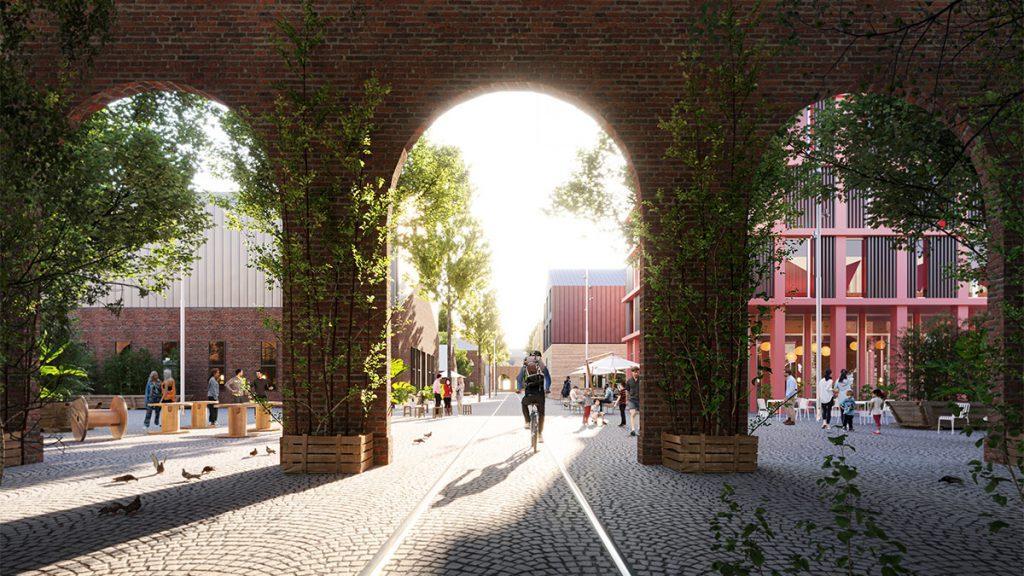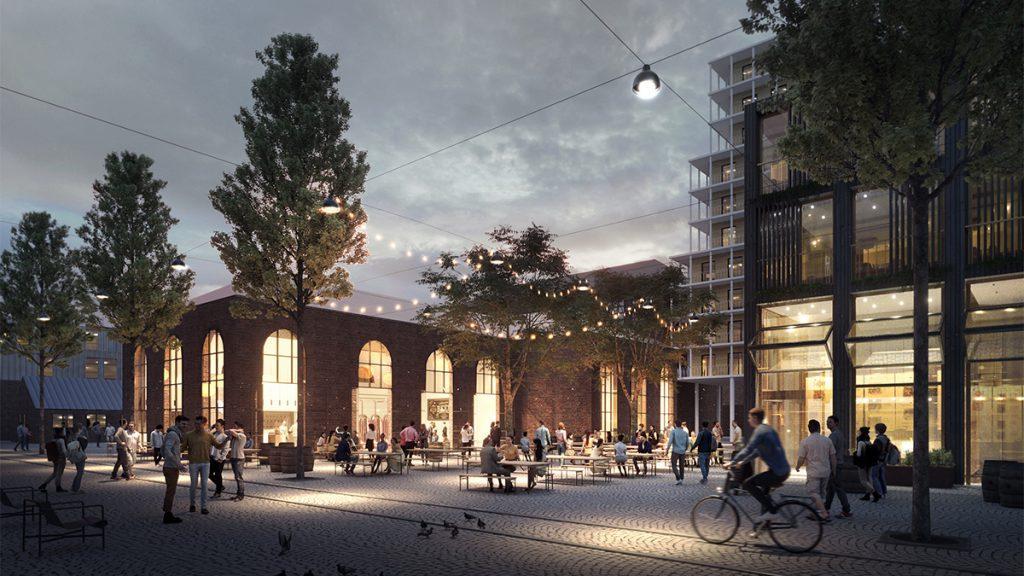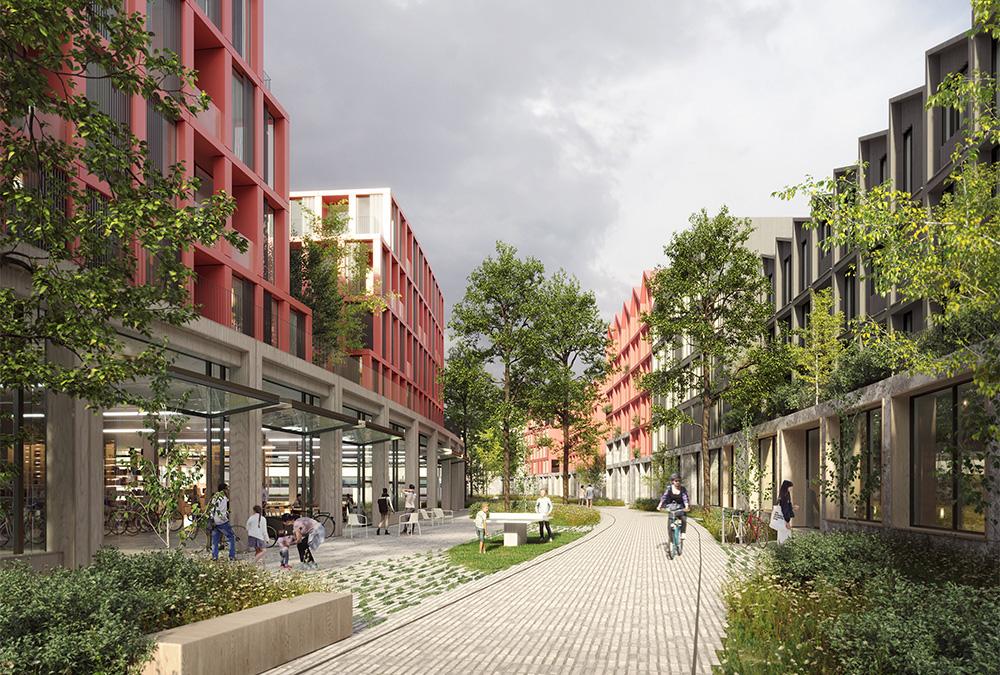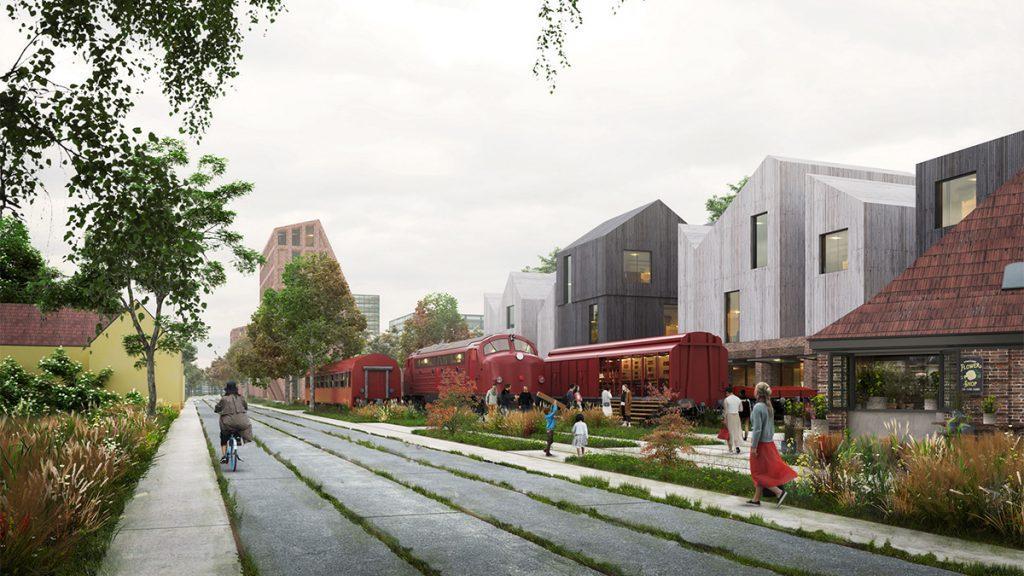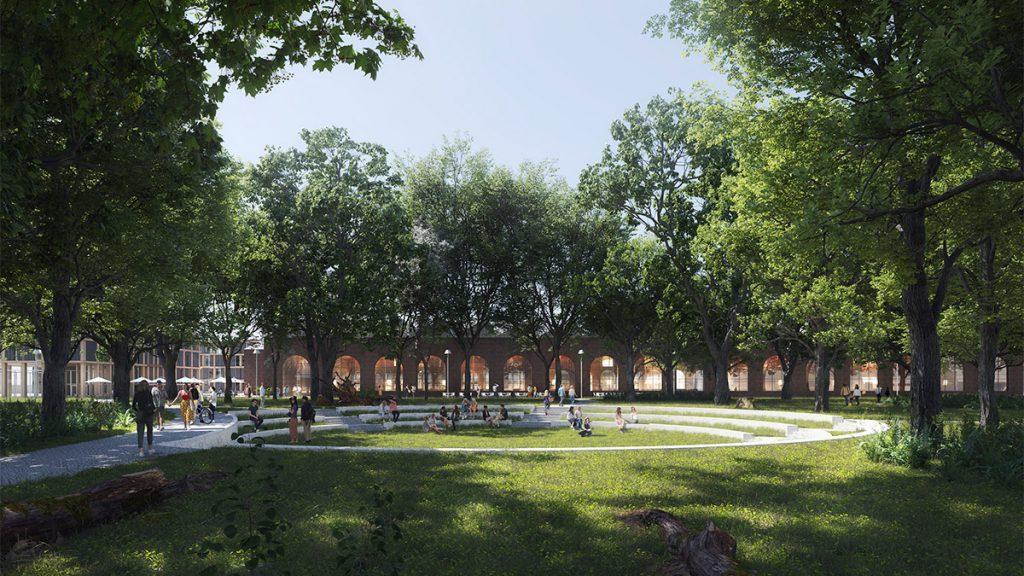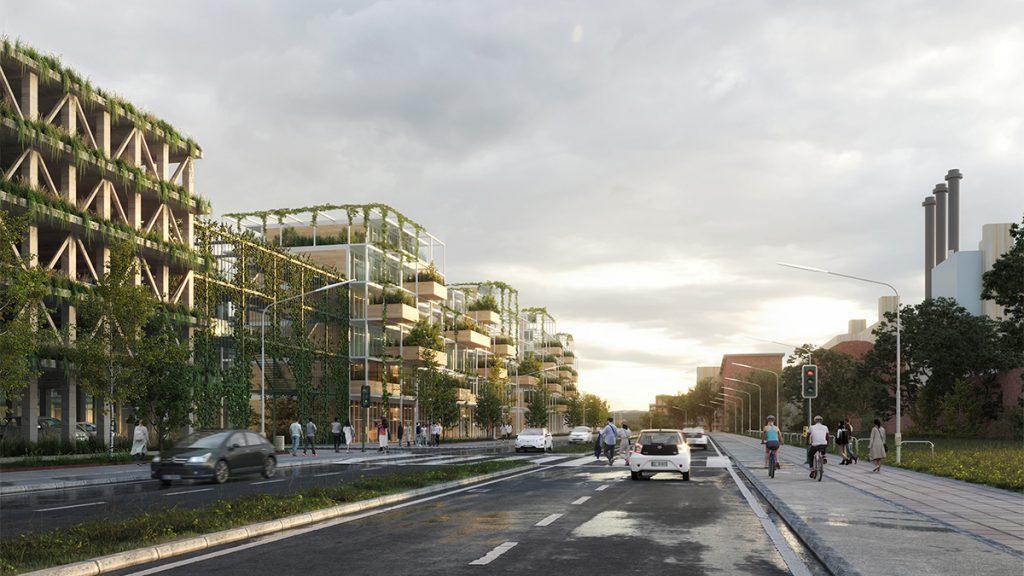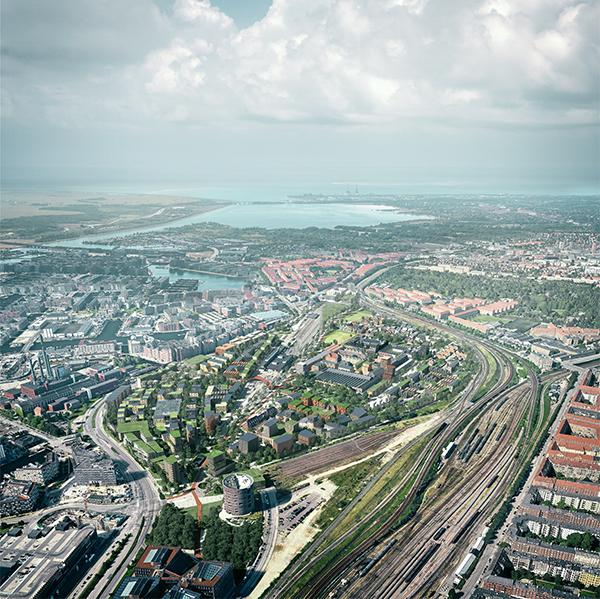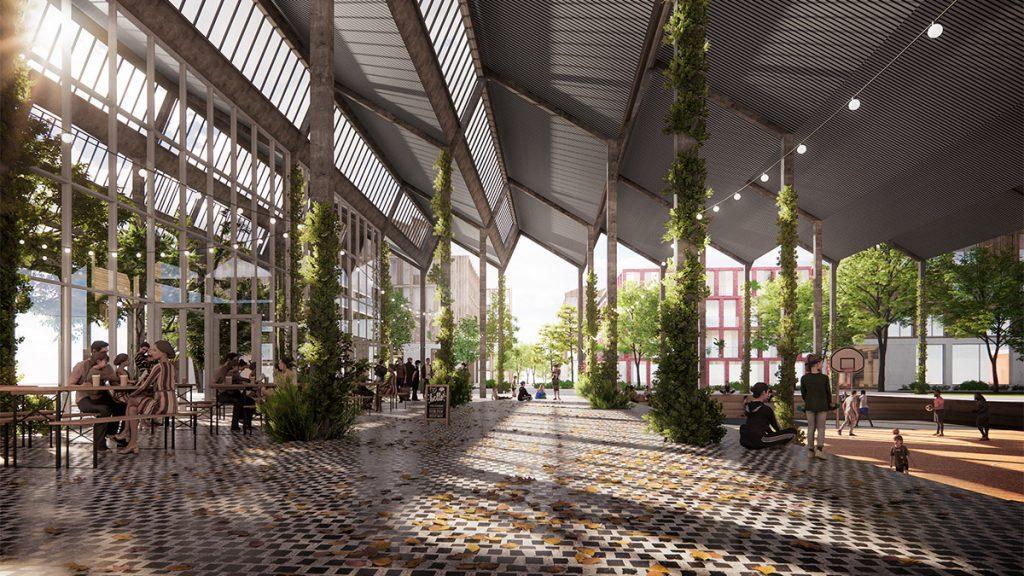New green district in Copenhagen
Jernbanebyen is being developed right in the centre of Copenhagen, based on plans drawn up by Danish architectural office Cobe. Formerly a railroad yard, the area is being transformed into an innovative green district. It will be partially car-free, with repurposed listed buildings and lots of new ideas for improving the quality of life.
Many European cities are plagued by housing shortages and rising real estate prices, and Denmark’s beautiful capital is no exception. The urban development plan kp19 aims to meet the growing demand for ways to live sustainably and close to nature. And it will also create affordable housing, for example with projects like Jernbanebyen. A vibrant, people-friendly and environmentally sound district is being built on a 550,000 m² site in a former railroad yard in the centre of Copenhagen.
Multifaceted large-scale project
The fascinating master plan for Jernbanebyen (“railway district”) comes from Copenhagen-based architectural office Cobe. It includes car-free neighbourhoods in which traditional streets are replaced with green areas for cyclists and pedestrians. The industrial site formerly operated by Danish rail company DSB will be brought to life again in a modern form. As a place for product development, manufacturing and sales, it will bring people together in different ways. The listed production buildings here will be converted into workshops for creative companies and start-ups, for instance.
Jernbanebyen is set to become an area of rich contrasts as an inviting combination of past and future. Historical industrial buildings and railway tracks will be joined by green spaces, apartments, shops, eateries, community facilities and culture. Copenhagen’s new district is paving the way for a better, more sustainable kind of city life. Complete with 4,500 new apartments, workspaces for 8,000 people, over 11 hectares of green spaces and eight hectares of green streets. Many DSB facilities will be moving out of the area to make room for the attractive new venture.
Nature and city life interwoven
Cobe’s plan creates a green fabric within an urban framework. Priority will be given to pedestrians and cyclists, while all residential areas and workplaces will be located near green spaces and trees. Jernbanebyen’s green network extends across the surrounding area, branching out into a delta of landscaped urban spaces and connections.
Master plan with five “pillars”
Jernbanebyen’s development is based on five pillars, each playing its part in the overall plan for the district. These specifications also ensure that its main structure and underlying qualities remain intact. The “Green Voids” – the network of urban green spaces – provide an overall structure and enhance the quality of life. The “Network” weaves the landscape into the urban development. Noise is managed through a “Pearl Necklace” of local solutions neatly surrounding the grounds.
Pillar No. 4 is the “Everyday City” strategy: Jernbanebyen is divided up into different smaller districts, each with its own individual character. Here, the specific qualities and challenges associated with each place serve as a starting point for further development. The fifth pillar pays tribute to the site’s industrial history: as a “City of Production”, Jernbanebyen will maintain the heritage of the past by preserving, transforming and reviving historical buildings.
Ten-hectare park as backbone
The green zones form a cohesive network of landscaped urban spaces. And they also bring spacious parks to the heart of Copenhagen. The master plan for Jernbanebyen distinguishes between four different types of nature. Type one is “Cultural Nature”: with three large parks, it connects the district from north to south with the surrounding green urban structures. Type two stands for the “Railway Nature”, i.e. the areas along the railway line that create a coherent east-west connection.
Zones that are associated with the former industrial buildings are termed “Local Nature”. These urban spaces are staged and used as anchor points in the development process. This means that each individual quarter will have its own unique meeting place. The name given to the fourth type is “Infra Nature”. This is because residents of Jernbanebyen – some parts of which are entirely car-free – can enjoy nature at first hand. According to the plan, all streets are designed as attractive community areas.
Fewer roads, more green
The architects at Cobe want to make more room for nature with car-free streets that reduce traditional road space by up to 50 percent. Streets become green corridors that provide fresh air and lush urban vegetation. This in turn adds value for residents, while improving the city climate and promoting biodiversity.
Roads are reduced to a width of five metres; cars will be kept in multi-storey car parks on the outskirts of the site. The principal green links also serve as the main connections for cyclists and pedestrians. Self-driving buses will connect Jernbanebyen with Copenhagen’s public transport system. In addition, an existing customs hall will become a roofed area for people to hang out – complete with an orangery and a locally managed café.
Sophisticated noise protection
As Jernbanebyen is located between busy traffic routes and railway lines, noise protection plays a key role in Cobe’s master plan. This is achieved through the aforementioned “Pearl Necklace”, which includes elements such as the multi-storey car parks on the outskirts of the new district. Here, the green walls buffer noise while also providing a home for birds and insects.
Quiet and close to nature
New residential buildings come with communal balconies that combine between four and six apartments with extensive vegetation that effectively serves as a noise screen. Vertical parks, extensive façade greening and strategically positioned industrial and commercial buildings all contribute to the acoustic protection wall that keeps noise to a tolerable minimum.
Jernbanebyen’s various parts, defined by the green concept, give rise to a wide range of possibilities that attract different target groups. For instance, the railway district offers room for the “self-made”, as it is called in the project description. Here, small building plots are available for small and medium-sized developers and for community life. On the other hand, the “Central Workshop Neighbourhood” is the heart of the development. Its uniqueness is based on the history of the area, which is structured according to the existing workshop buildings. And losing your way in the staggered streets of its centre has a charm all of its own.
Diversified urban district
On approaching Jernbanebyen from the west, you first arrive in the “Production Neighbourhood”. Here, you can find one of the most important existing workshop buildings, which is to be gradually converted into new production facilities – surrounded by creative companies and different types of housing and institutions.
The “South-West Passage” is a new, green bicycle path that will connect Jernbanebyen with the surrounding city. This new route through Copenhagen will be linked with active urban spaces, outdoor fitness areas and training facilities on the roofs of the multi-storey car parks. The centrally positioned “Wedge” is a mixed-use zone that opens up into two green and inviting inner urban spaces.
Right on track for the future
Another key part of the project is the “Track Neighbourhood”. This area is shaped by winding green streets with plenty of space for living, exercise and fun. At the heart of the neighbourhood, existing buildings form the framework for a new covered urban space where events for the local community or the entire city can be held all year round.
Cobe’s architectural concept demonstrates once again the beauty and practicality of revitalizing historical buildings and combining them with modern urban development. This can also be seen from major projects like on the site of the deserted Codrico Terrain in Rotterdam or the repurposed Imperial Shipyard in Gdańsk.
Initial project stages
Work has already begun on this sustainable, forward-looking district of Copenhagen. Commissioned by state railway DSB Ejendomsudvikling and real estate company Freja Ejendomme, it is being built on the last undeveloped industrial site in the city centre.
As part of the Toldkammer building, Spor10 is already bringing people together for cultural, creative and physical activities. Indeed, the whole district is certain to be a big hit with its residents – and also with the city itself. With its shortage of affordable housing similar to that of other global cities, this new development is a welcome opportunity for Copenhagen.
Text: Elisabeth Schneyder
Translation: Rosemary Bridger-Lippe
Images: Cobe
